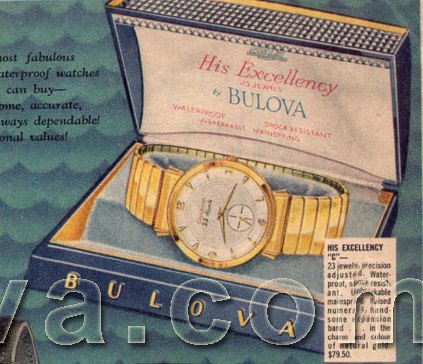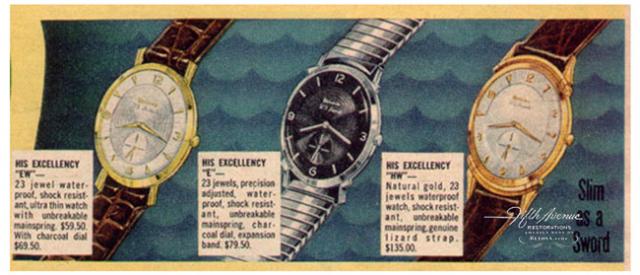I decided "C" over "EW" because variant "C" specifies precision adjustments where "EW" does not. Movement has 6 Adjustments

'EW' on Leather.
http://www.mybulova.com/sites/default/files/vintage_ads/Bulova_AD_1958_…
as the ad clearly shows.

...but the logic of "percission adjusted" in the "C" text at top makes sense too. They had room to put those two words in the description of the "EW", so they left them out for a reason...but would the adjustments of a movement change the model name or variant designation? I'm also looking thorugh all 10PB 23 jewel mvnts on site, and it's looking like for 1958/59 all of these are "heat cold Isochronism 6 adj".
"EW" ad shows leather, and "C" ad both shows and states expansion band. I don't think just putting it on a period colse/ad close expansion band cuts it either.... This may be one of the instances where it's difficult to say if it's an EW or a C, but I'd probably confirm it could be both.
EDIT: ...and thanks for entering this one Jared. This will be a fun one to work through!
In reply to What logic is that Will? The by FifthAvenueRes…
...when one looks at just that one ad, without any extra knowledge of all being precession adjusted, I can see how the "C" could be chosen over the "EW" based on the "precession adjusted" statement. I must I disregard the expansion band text to do so (which may make the variant in this example). When I look at various examples in the database and some other stuff, I'm still not sure the "C" and "EW" can be distinguished between unless they have the original bands or maybe a hang tag with them. I think this could be one of those instances where I can't confirm it's one or the other. Like I said, a fun one to work through.
If we disregard the mount and imagine the watch being entered without any band, can we tell the difference between "EW" and "C"? The mounts are one of the first things to "go". The $20 price difference for just the band is kinda high, like OT points out. The "E" w/ charcoal dial and expansion band is also $79, and we sometimes see the same watch with charcoal dial costing more... like it says in the text for the "EW".
Lots to work/think through.
The expansion bands on these were Gold Filled or Plate, matching the Case compositon making $20 more than justifiable and the ID has absolutely nothing to do with the Movement as they were all the same. - 23 Jewels timed to 6 adjustments - precision adjusted.
The ad clearly shows this Case on a Leather strap as the 'HIS EXCELLENCY' "EW" variant, no arguement.
In reply to The expansion bands on these by FifthAvenueRes…
Here is a bit of history on Gold...
The Gold Reserve Act of 1934 made gold clauses unenforceable, and changed the value of the dollar in gold from $20.67 to $35 per ounce. This price remained in effect until August 15, 1971, when President Richard Nixon announced that the United States would no longer convert dollars to gold at a fixed value, thus abandoning the gold standard for foreign exchange
At $35 a ounce, a Gold filled band would not have a $20.00 bump in 1958, because it cost the same from 1934 to 1971 factoring in inflation...a combination of movement quality, case composition, and band composition might, or were they were using it as a price leader....and why would they put a Gold filled band on a RGP case??
